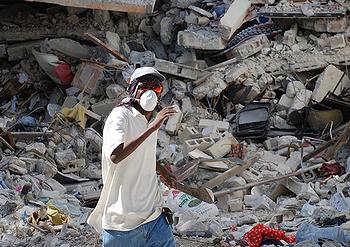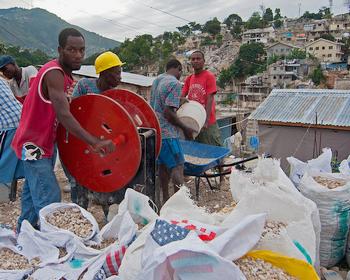Recycling Haiti’s Earthquake Rubble Into Safe, Strong Concrete
ATLANTA, Georgia, January 6, 2011 (ENS) – Nearly one year after a severe earthquake devastated Haiti, most of the damaged areas are still in ruins. But today, engineering and concrete experts at the Georgia Institute of Technology published a method of recycling Haiti’s estimated 20 million cubic yards of broken concrete and other rubble into strong new construction material. Their solution is published in the journal “Bulletin of the American Ceramic Society.”
Born in Haiti, earthquake engineering specialist Reginald DesRoches is now associate chair of the Civil and Environmental Engineering Department at Georgia Tech. Since the January 12, 2010 earthquake, he has traveled several times to the capital Port-au-Prince to gather samples of typical concrete rubble and sand types used as fine aggregates in making concrete.
 |
Georgia Tech professor Reginald DesRoches (Photo courtesy Georgia Tech) |
“The commodious piles of concrete rubble and construction debris form huge impediments to reconstruction and are often contaminated,” says DesRoches. “There are political and economic dilemmas as well, but we have found we can turn one of the dilemmas – the rubble – into a solution via some fairly simple methods of recycling the rubble and debris into new concrete.”
In Port-au-Prince, DesRoches and Georgia Tech researcher Joshua Gresham encountered no mixing trucks and found that local laborers all mixed their concrete by hand in small batches.
“Unfortunately,” said DesRoches, “they were mixing volumes of materials by eye, an unreliable practice that probably caused much of the poor construction and building failure during the earthquake.”
In Haiti, DesRoches and Gresham manually cast an initial set of standard 3-inch by 6-inch concrete test blocks, using mixes from several different construction sites.
 |
Haiti must deal with mountains of mixed rubble left by the earthquake. Port-au-Prince, January 16, 2010. (Photo by IFRC) |
They returned to Georgia Tech with their cast blocks, sand samples and notes, where they discovered that the concrete blocks cast in Haiti were of inferior quality.
“The Haitian-made concrete had an average compressive strength of 1,300 pounds per square inch,” says Kimberly Kurtis, a Georgia Tech professor and chair of the American Concrete Institute’s Materials Science of Concrete Committee.
“In comparison, concrete produced in the U.S. would be expected to have a minimum strength of 3,000 pounds per square inch,” said Kurtis.
For a second round of tests, the researchers manually crushed rubble samples with a hammer to provide coarse aggregate, used sands collected in Haiti and mixed the batches by hand. But this time, instead of estimating the amounts of materials they measured volumes using methods prescribed by the American Concrete Institute.
This time the blocks showed an average strength of more than 3,000 pounds per square inch.
“Based upon these results, we now believe that Haitian concrete debris, even of inferior quality, can be effectively used as recycled coarse aggregate in new construction,” said Kurtis. “It can work effectively, even if mixed by hand. The key is having a consistent mix of materials that can be easily measured. We are confident are results can be scaled up mix procedure where quantities can be measured using common, inexpensive construction equipment.”
 |
Haitians use USAID-funded rubble crusher to manage broken concrete in Delmas 32, Port-au-Prince, December 15, 2010. (Photo by Ben Edwards courtesy USAID) |
DesRoches said recycling concrete rubble into new building material eliminates two hurdles to reconstruction.
“First, removing the remaining debris is nearly impossible because there are few, if any, safe landfill sites near Port-au-Prince, and the nation lacks the trucks and infrastructure to haul it away. It is better to use it than to move it.”
“Second,” he said, “Finding fresh aggregate is more difficult than getting rid of the debris. It is costly to find, mine and truck in.”
DesRoches, Kurtis and Gresham plan to share their research results with Haitian government officials and nongovernmental organizations working on reconstruction projects.
Use of recycled concrete aggregate is not unprecedented. It is used worldwide for roadbeds and drainage, and some European countries use up to 20 percent recycled aggregates in structural concrete.
“More work must be done to characterize the recycled materials, test additional performance parameters and gauge the safest ways to crush the rubble,” said DesRoches. “Seismic behavior and building codes must be studied. But, these tests can and should be done dynamically, during reconstruction, because the benefits can be so immediate and significant.”
DesRoches is hopeful that a debris strategy and infrastructure will emerge once Haiti’s disputed presidential elections are resolved. “Some think that many rebuilding projects have on hold for the past few months because of distraction from the elections,” he said.
The next round of elections was supposed to be held on January 16, but Haiti election officials said Wednesday they will not be able to hold a presidential runoff election until late February. They are waiting for a report on preliminary results from the country’s disputed first round in November 2010.
Copyright Environment News Service (ENS) 2011. All rights reserved.
